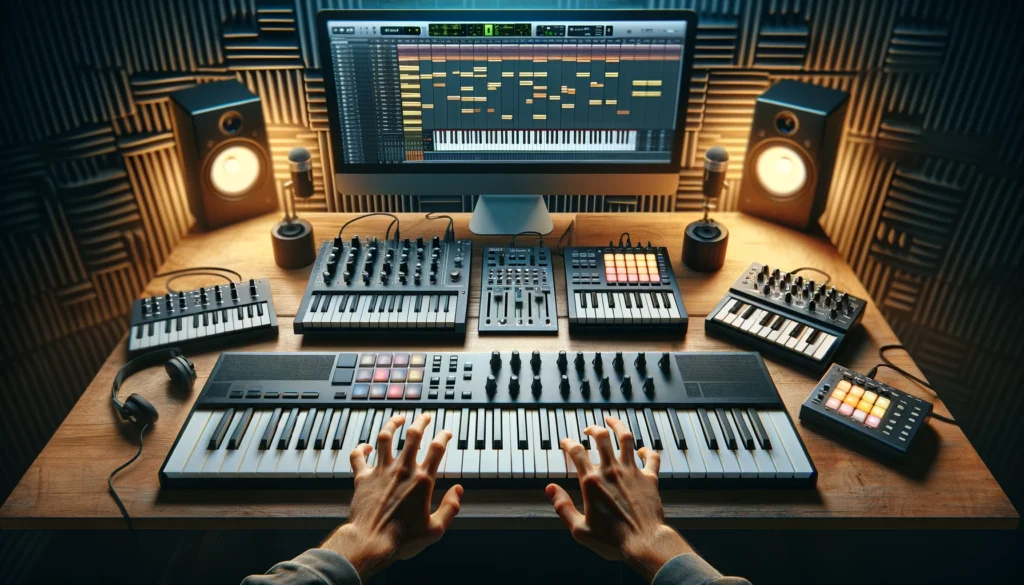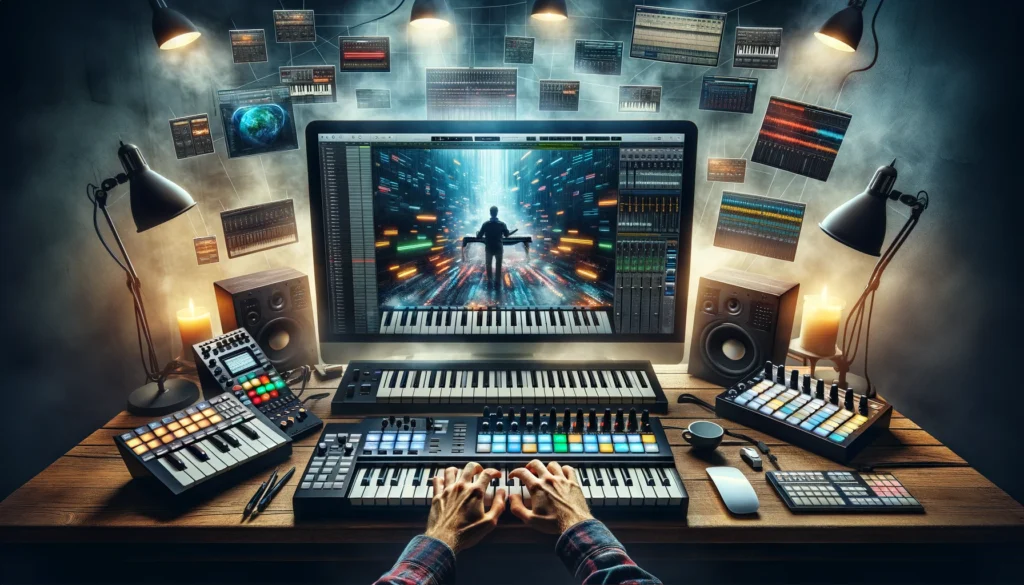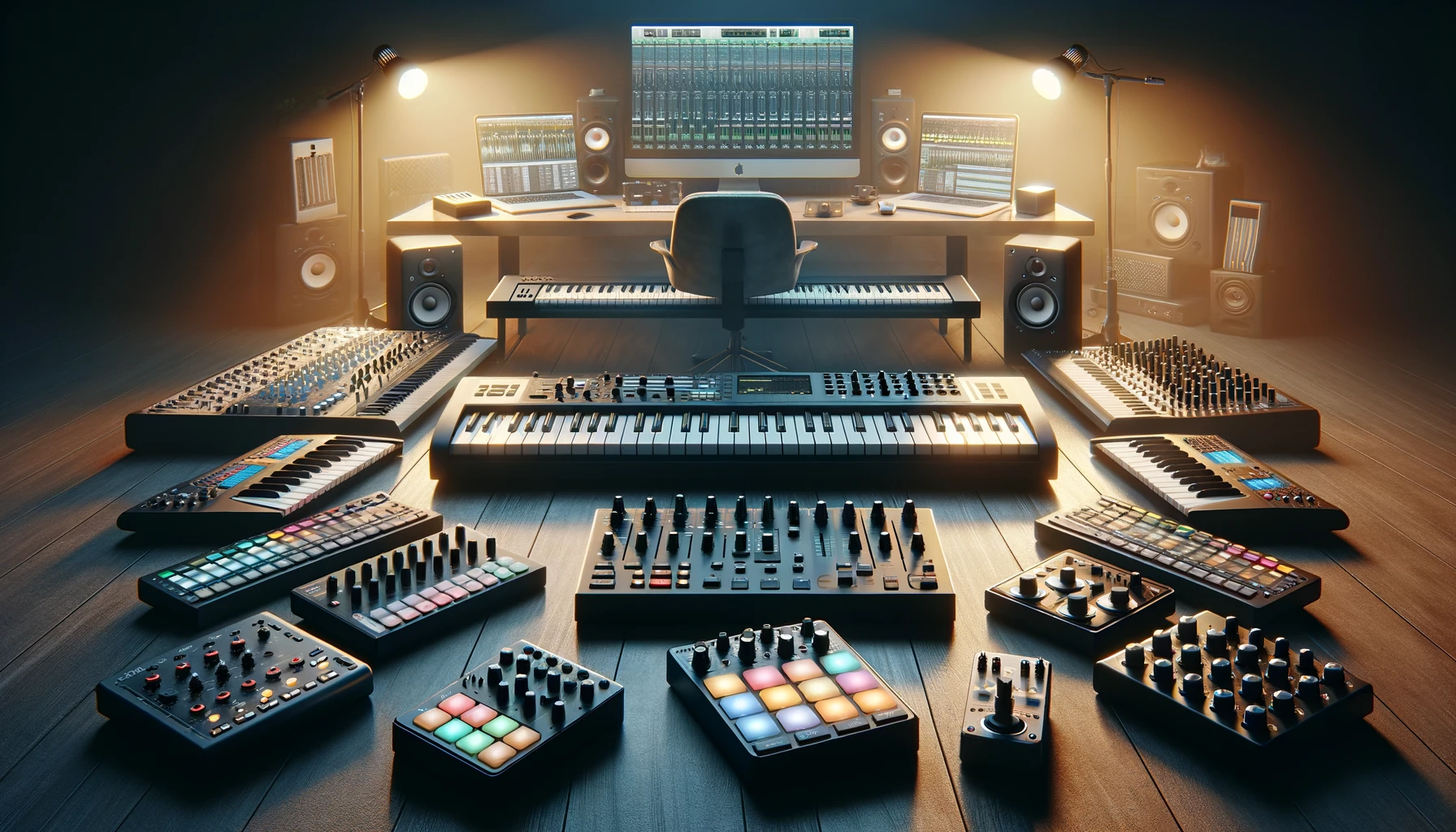Have you ever wondered what the difference is between a MIDI keyboard and a MIDI controller? With the increasing popularity of virtual instruments and digital music production, many musicians are turning to MIDI devices.
But the distinction between MIDI keyboards, which resemble standard piano-style playing surfaces, and MIDI controllers, which come in various other forms, is often unclear.
In this article, we will break down the key similarities and differences between MIDI keyboards and MIDI controllers so you can decide which type is right for your music setup.
Without further ado, let’s explore what sets these indispensable modern music tools apart.
The difference between a MIDI keyboard and a MIDI controller

The key difference between a MIDI keyboard and a MIDI controller comes down to sound generation capabilities.
MIDI keyboards contain onboard sounds and synth engines to produce audio in addition to sending MIDI messages.
Controllers solely focus on parameter control rather than sound creation.
As we’ll explore below, this core distinction leads to divergence across form factors, main functions, and usage scenarios.
What is a MIDI Keyboard?

A MIDI keyboard is an electronic musical instrument that can generate and send MIDI data to other devices.
MIDI keyboards contain keys, buttons, knobs and other controls that when played or pressed, generate MIDI messages.
The most common type of MIDI keyboard is one with piano-style keys that resembles the keyboard of a piano or synthesizer.
MIDI keyboards allow musicians to trigger and control sounds and virtual instruments on external sound modules, computers, tablets and other devices by sending MIDI data.
The MIDI keyboard itself produces no sound on its own, it simply sends MIDI instructions to the receiving device that generates or plays the sounds.
MIDI keyboards come in various key ranges – 25 keys, 49 keys, 61 keys, 76 keys, 88 keys – similar to the key ranges found on real pianos.
Full-size 88-key MIDI keyboards provide the full scope of notes available on a real piano.
MIDI keyboards use velocity-sensitive keys that sense how hard or soft a key is struck when played.
This velocity information is transmitted via MIDI to the receiving instrument or device.
MIDI keyboards give musicians a realistic piano-style playing experience and method to input notes and musical performances into external sound sources.
What is a MIDI Controller?

A MIDI controller is a device that is used to remotely control parameters like volumes, instrument selections, effects, transports controls and other options on an external sound module or software instrument.
MIDI controllers come in many forms – keyboard controllers, drum pad controllers, wind instrument controllers, DJ controllers and more.
The main purpose of a MIDI controller is MIDI control and manipulation rather than sound generation itself.
The buttons, knobs, faders, pads and keys on a MIDI controller are mapped to various parameters and functions on the target device or software.
By tweaking the physical controls on the MIDI controller, musicians can shape the sound without having to adjust settings on the device itself.
This allows for hands-on control and dynamic performances.
For example, on a MIDI keyboard controller, the modulation wheel might be mapped to control a vibrato effect in a virtual instrument.
Some MIDI controllers include automapping capabilities that automatically link controls to parameters in compatible software.
While MIDI keyboards have piano-style keys for playing and performing musical parts, MIDI controllers may or may not have keys and often use pads, buttons and other unconventional inputs.
The focus is on control rather than playing ability.
MIDI controllers are used extensively in computer-based recording setups and live performances to control soft synths, effects, DJ software and more.
The choice, form and size of a MIDI controller depends on the target application.
Similarities Between MIDI Keyboards and Controllers

While MIDI keyboards and MIDI controllers have some differences in their primary functions, there are also some prominent similarities between the two device types when it comes to connectivity, configuration, capabilities and compatibility.
Both MIDI keyboards and MIDI controllers connect to other devices to send MIDI data.
The connection is usually established digitally over a USB cable, though traditional 5-pin MIDI cables can still facilitate MIDI connections between devices.
Both types of devices include some kind of controls like keys, pads, faders or buttons that can be used to transmit MIDI instructions to an instrument or computer software.
Both devices can map their controls to parameters in a MIDI-compatible hard synth or software instrument so that tweaking the hardware controls shapes the sound in real time.
In terms of capabilities, there is some overlap between MIDI keyboards and controllers.
Many MIDI keyboards now include knobs, sliders and function buttons in addition to the standard piano-style keys.
This allows them to operate as dual purpose keyboard/controllers suitable for both playing parts and controlling parameters.
On the other hand, some small MIDI keyboard controllers are capable of generating a few onboard sounds in addition to their primary control functionality.
So the line between the two device categories is somewhat blurred in terms of what they can do.
Lastly, both MIDI keyboards and MIDI controllers use a standard MIDI protocol for communication between devices and software.
This ensures broad compatibility and interoperability with a wide range of MIDI-enabled hardware and software instruments, recording programs, live performance setups and more.
Just about any MIDI keyboard or MIDI controller on the market today can interface with any MIDI-capable synth, sampler or digital audio workstation software.
Differences Between MIDI Keyboards and Controllers

While MIDI keyboards and controllers share some common traits, there are also clear differences between these two types of devices relating to sound generation, form factors available, and primary functions.
MIDI keyboard instruments have onboard sound engines and synthesizers that allow them to generate sounds directly without being connected to other gear.
Many keyboards include quality piano, organ, string ensemble and other sounds for practice and performance situations where an external sound module is not required.
MIDI controllers have no onboard sound engines and must be connected to something else to produce audio.
MIDI controllers come in a much wider variety of form factors than traditional keyboards.
Drum pad controllers, wind controllers, foot controllers and DJ-style controllers can all operate over a MIDI connection to manipulate external sounds but do not offer the standard piano keyboard layout that MIDI keyboard instruments provide.
MIDI controllers are highly specialized for certain applications like video game music scoring, DJ software control, and triggering samples whereas MIDI keyboards take the familiar form of piano substitutes.
The main focus of MIDI keyboards is playing and performing musical parts using the on-board sounds or by driving sounds on an attached computer or sound module.
The default configuration maps the keys to notes and velocities to emulate the piano playing experience.
With MIDI controllers, the focus is more on controlling options and parameters to shape the sound during music production and performance rather than playing parts.
MIDI controllers usually control functions like transport controls, effects settings and mixer levels rather than directly generating sequences of notes and chords.
While the two categories have some overlap, MIDI keyboards are more optimized for playing and performing musical parts complete with standard piano-style keyboards.
MIDI controllers encompass a wider range of form factors and specialized devices with the focus being more on music production control rather than performing keyboard-based compositions directly.
Both remain indispensable tools for computer-based songwriting, recording, and live playing with software instruments.
Conclusion
In closing, while MIDI keyboards and controllers take different forms and have areas of specialization, the core purpose is similar – to interface with computers, tablets, phones and sound modules for manipulating virtual instruments and controlling music software.
With an understanding of the nuanced differences in keys, focus, and form factors, musicians can select the optimal MIDI device for their performance and production needs and styles.
Whether keys or pads, MIDI remains vital to computer-era music workflows.
